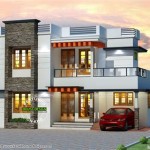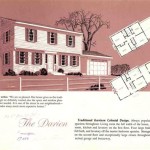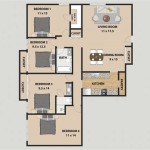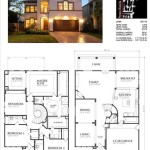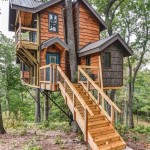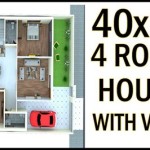Modern Architecture House Floor Plans
Modern architecture emphasizes functionality, clean lines, and a connection with the surrounding environment. Floor plans for modern homes reflect these principles through open-concept layouts, strategic use of natural light, and a focus on efficient use of space. This exploration delves into key considerations within modern house floor plans, offering insights into the design elements that contribute to their distinctive style and practicality.
Key Features of Modern House Floor Plans:
* Open-Concept Living Spaces: Walls are minimized to create expansive, interconnected areas for living, dining, and kitchen activities. * Connection to the Outdoors: Large windows and glass doors blur the lines between interior and exterior spaces, bringing natural light and views inside. * Simple Geometric Forms: Rectangular, square, and L-shaped floor plans are common, reflecting the minimalist aesthetic of modern design. * Flat Roofs: A signature element of modern architecture, flat roofs contribute to the clean, streamlined appearance and can provide opportunities for rooftop gardens or terraces.
Prioritizing Functionality in Floor Plan Design:
* Efficient Space Utilization: Every square foot is maximized to ensure optimal functionality and avoid wasted space. * Designated Zones: While open, spaces are strategically zoned for distinct activities, maintaining a sense of order within the open layout. * Built-in Storage: Integrated storage solutions are incorporated seamlessly into the design, contributing to a clutter-free environment. * Emphasis on Natural Light: Windows and skylights are carefully positioned to maximize natural light penetration, reducing the need for artificial lighting.
The Role of Natural Light and Ventilation:
* Maximizing Natural Light: Large windows, strategically placed skylights, and clerestory windows bring in ample natural light, reducing energy consumption and creating a brighter, more inviting atmosphere. * Cross-Ventilation Strategies: Floor plans are often designed to facilitate natural cross-ventilation, promoting airflow and reducing the reliance on air conditioning. * Orientation Considerations: The orientation of the house on the site is carefully considered to maximize solar gain in winter and minimize overheating in summer.
Adaptability and Flexibility in Modern Floor Plans:
* Multi-Functional Spaces: Rooms are designed to serve multiple purposes, accommodating changing needs and lifestyles. * Flexible Floor Plans: Open layouts allow for easy reconfiguration of furniture and spaces as needed. * Future-Proofing Considerations: Modern floor plans often incorporate elements that anticipate future needs, such as provisions for home offices or accessory dwelling units.
Integrating Indoor and Outdoor Living:
* Seamless Transitions: Large sliding glass doors, patios, and decks create smooth transitions between indoor and outdoor living areas. * Outdoor Rooms: Covered patios, pergolas, and outdoor kitchens extend living spaces beyond the confines of the house. * Landscaping Integration: The surrounding landscape is often integrated into the design, creating a harmonious connection between the built environment and nature.
Materials and Finishes in Modern Design:
* Emphasis on Natural Materials: Wood, concrete, and stone are often used in modern homes, adding warmth and texture. * Minimalist Palette: Neutral color palettes are common, creating a sense of calm and spaciousness. * Industrial Influences: Exposed ductwork, concrete floors, and metal accents can add an industrial touch to modern interiors.
Considering Sustainability in Modern House Plans:
* Energy Efficiency: Modern floor plans are often designed to optimize energy efficiency through passive solar design, insulation, and high-performance windows. * Water Conservation: Water-efficient fixtures and landscaping are incorporated to reduce water usage. * Sustainable Materials: The use of recycled and locally sourced materials minimizes the environmental impact of construction.
Different Styles Within Modern Architecture:
* Mid-Century Modern: Characterized by clean lines, organic shapes, and integration with nature. * Minimalism: Focuses on essential elements and eliminates unnecessary ornamentation. * Contemporary: A broader category that encompasses current trends and interpretations of modern design. * International Style: Emphasizes geometric forms, open floor plans, and the use of industrial materials.
Analyzing Site Conditions and Context:
* Site Analysis: The topography, orientation, and surrounding environment are carefully considered when designing a modern home. * Contextual Design: The design of the house should respond to the specific characteristics of the site and its surroundings. * Views and Privacy: Floor plans are designed to maximize desirable views while maintaining privacy.

Two Y Floorplan The Odyssey By National Homes Architectural Design House Plans Modern Floor

Modern Open Floor House Plans Blog Eplans Com

Modern Villa V Designed By Ng Architects Www Ngarchitects Eu Architecture House Construction Plan Design

I Love These Designs For Houses They Em Are Future Ristic An Architect Village House Design Architectural Plans Modern Villa

A Vaastu Home With Its Modern Traditional Elements Studio Imagine The Architects Diary Design Floor Plans House Layout Model Plan

22 House Design With Floor Plans You Will Love Simple Two Story Affordable Plan Gallery

20x52 6 Residential Dream House With Its Floor Plan And Elevation Minimal Design Small Exterior Architect

4 Bedroom Home Design Plan 7 5x9m Samphoas Plansearch Beautiful House Plans Front Construction

Architectural 2d House Floor Plan For Construction Hyderabad

Discover The Plan 3883 Essex Which Will Please You For Its 4 Bedrooms And Contemporary Styles House Plans Beautiful Construction

